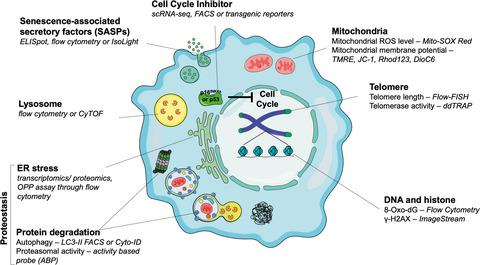当前位置:
X-MOL 学术
›
Aging Cell
›
论文详情
Our official English website, www.x-mol.net, welcomes your
feedback! (Note: you will need to create a separate account there.)
Hallmarks and detection techniques of cellular senescence and cellular ageing in immune cells
Aging Cell ( IF 8.0 ) Pub Date : 2021-02-01 , DOI: 10.1111/acel.13316 Dingxi Zhou 1 , Mariana Borsa 1 , Anna Katharina Simon 1
Aging Cell ( IF 8.0 ) Pub Date : 2021-02-01 , DOI: 10.1111/acel.13316 Dingxi Zhou 1 , Mariana Borsa 1 , Anna Katharina Simon 1
Affiliation

|
The ageing of the global population brings about unprecedented challenges. Chronic age‐related diseases in an increasing number of people represent an enormous burden for health and social care. The immune system deteriorates during ageing and contributes to many of these age‐associated diseases due to its pivotal role in pathogen clearance, tissue homeostasis and maintenance. Moreover, in order to develop treatments for COVID‐19, we urgently need to acquire more knowledge about the aged immune system, as older adults are disproportionally and more severely affected. Changes with age lead to impaired responses to infections, malignancies and vaccination, and are accompanied by chronic, low‐degree inflammation, which together is termed immunosenescence. However, the molecular and cellular mechanisms that underlie immunosenescence, termed immune cell senescence, are mostly unknown. Cellular senescence, characterised by an irreversible cell cycle arrest, is thought to be the cause of tissue and organismal ageing. Thus, better understanding of cellular senescence in immune populations at single‐cell level may provide us with insight into how immune cell senescence develops over the life time of an individual. In this review, we will briefly introduce the phenotypic characterisation of aged innate and adaptive immune cells, which also contributes to overall immunosenescence, including subsets and function. Next, we will focus on the different hallmarks of cellular senescence and cellular ageing, and the detection techniques most suitable for immune cells. Applying these techniques will deepen our understanding of immune cell senescence and to discover potential druggable pathways, which can be modulated to reverse immune ageing.
中文翻译:

免疫细胞衰老的标志和检测技术
全球人口老龄化带来前所未有的挑战。越来越多的人患有与年龄相关的慢性疾病,给健康和社会护理带来了巨大的负担。由于免疫系统在病原体清除、组织稳态和维持方面发挥着关键作用,因此免疫系统会随着衰老而恶化,并导致许多与年龄相关的疾病。此外,为了开发针对 COVID-19 的治疗方法,我们迫切需要获得更多有关老年免疫系统的知识,因为老年人受到的影响不成比例且更为严重。随着年龄的变化会导致对感染、恶性肿瘤和疫苗接种的反应受损,并伴有慢性、低度炎症,统称为免疫衰老。然而,免疫衰老(称为免疫细胞衰老)背后的分子和细胞机制大多未知。细胞衰老以不可逆的细胞周期停滞为特征,被认为是组织和有机体衰老的原因。因此,在单细胞水平上更好地了解免疫群体中的细胞衰老可能会让我们深入了解免疫细胞衰老在个体的一生中如何发展。在这篇综述中,我们将简要介绍衰老的先天性和适应性免疫细胞的表型特征,这也有助于整体免疫衰老,包括亚群和功能。接下来,我们将重点关注细胞衰老和细胞老化的不同标志,以及最适合免疫细胞的检测技术。应用这些技术将加深我们对免疫细胞衰老的理解,并发现潜在的药物途径,通过调节这些途径可以逆转免疫衰老。
更新日期:2021-02-16
中文翻译:

免疫细胞衰老的标志和检测技术
全球人口老龄化带来前所未有的挑战。越来越多的人患有与年龄相关的慢性疾病,给健康和社会护理带来了巨大的负担。由于免疫系统在病原体清除、组织稳态和维持方面发挥着关键作用,因此免疫系统会随着衰老而恶化,并导致许多与年龄相关的疾病。此外,为了开发针对 COVID-19 的治疗方法,我们迫切需要获得更多有关老年免疫系统的知识,因为老年人受到的影响不成比例且更为严重。随着年龄的变化会导致对感染、恶性肿瘤和疫苗接种的反应受损,并伴有慢性、低度炎症,统称为免疫衰老。然而,免疫衰老(称为免疫细胞衰老)背后的分子和细胞机制大多未知。细胞衰老以不可逆的细胞周期停滞为特征,被认为是组织和有机体衰老的原因。因此,在单细胞水平上更好地了解免疫群体中的细胞衰老可能会让我们深入了解免疫细胞衰老在个体的一生中如何发展。在这篇综述中,我们将简要介绍衰老的先天性和适应性免疫细胞的表型特征,这也有助于整体免疫衰老,包括亚群和功能。接下来,我们将重点关注细胞衰老和细胞老化的不同标志,以及最适合免疫细胞的检测技术。应用这些技术将加深我们对免疫细胞衰老的理解,并发现潜在的药物途径,通过调节这些途径可以逆转免疫衰老。






























 京公网安备 11010802027423号
京公网安备 11010802027423号